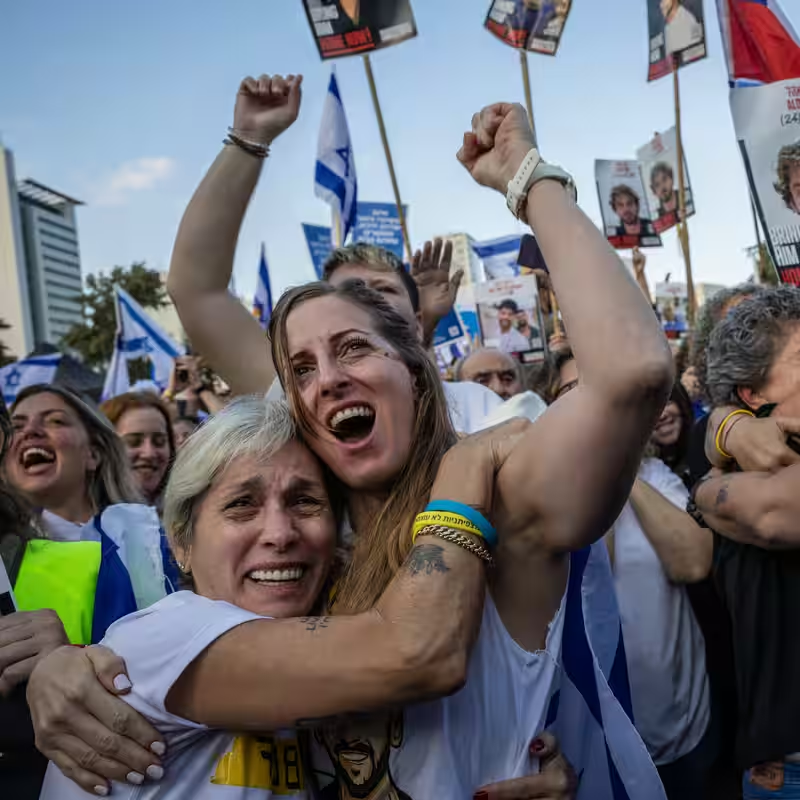Table of Contents
- Final Hostages Freed After Two-Year Ordeal
- Trump Declares End of War in Historic Knesset Address
- Netanyahu’s Absence Raises Questions
- Gaza in Ruins Despite Ceasefire
- What’s Next for Hamas?
- Sources
Final Hostages Freed After Two-Year Ordeal
On Monday, October 13, 2025, the last 20 living Israeli hostages held by Hamas were released, marking a pivotal moment in one of the most devastating conflicts in recent Middle Eastern history. In exchange, Israel freed approximately 2,000 Palestinian prisoners—a move that brought tearful reunions to families on both sides.
Among those released were Alon Ohel, 24; Avinatan Or, 32; and Matan Angrest, 22—men who had been held captive since the brutal October 7, 2023 attacks on Israel. Unlike earlier phases of the ceasefire, this final group consisted entirely of adult males; women, children, and elderly hostages had been returned in prior deals.
“Our nightmare is finally over. He’s almost here,” said Ilan Gilboa-Dalal, father of 24-year-old Guy Gilboa-Dalal, moments after learning his son was on his way home.
Trump Declares End of War in Historic Knesset Address
President Donald Trump, who arrived in Israel just as the exchange unfolded, addressed the Knesset with triumphant rhetoric. “This is the end of the age of terror and death,” he declared to a standing ovation. “This is the historic dawn of a new Middle East.”
Trump credited his administration’s 20-point peace plan—brokered with help from Egypt, Qatar, and Turkey—for bringing the warring sides to the table. The plan culminated in a full cessation of hostilities: no airstrikes, no artillery fire, and, for the first time since 2023, no living Israeli hostages in Hamas custody.
Key Numbers from the Exchange
| Category | Count |
|---|---|
| Israeli hostages released (final batch) | 20 |
| Palestinian prisoners freed by Israel | ~2,000 |
| Total Israeli deaths (Oct. 7, 2023) | ~1,200 |
| Palestinian deaths (Gaza health ministry estimate) | 67,000+ |
| Daily aid trucks entering Gaza (as of Oct. 13) | 600 |
Netanyahu’s Absence Raises Questions
Despite Trump’s declaration of peace, Israeli Prime Minister Benjamin Netanyahu notably skipped a high-level summit in Egypt meant to chart Gaza’s postwar future. Netanyahu cited the Jewish holiday of Shemini Atzeret as the reason—but his absence, coupled with his refusal to call the conflict “over,” cast doubt on the durability of the truce.
Netanyahu’s defense minister, Israel Katz, also expressed fury that Hamas delivered only four coffins containing remains of dead hostages—far short of the 26 bodies promised under the agreement. “Each delay or intentional avoidance will be considered a blunt violation,” Katz warned on social media.
Gaza in Ruins Despite Ceasefire
For many Palestinians, the ceasefire brought relief—but not joy. After 24 months of relentless bombardment, Gaza lies in ruins: homes flattened, hospitals nonfunctional, and tens of thousands dead. “It’s important the bombing has stopped, but there’s nothing to be happy about,” said Saed Abu Aita, a displaced father who lost two daughters in the war.
Still, hope flickers in the form of humanitarian aid. The U.N. reported “real progress” in aid delivery, with Israel now permitting 600 aid trucks per day—double the previous rate. Yet scenes of desperation persist, including footage of men swarming delivery trucks to grab food and supplies.
What’s Next for Hamas?
One of the biggest unresolved issues is the future of Hamas itself. The group has relinquished its most powerful bargaining chip—live hostages—but has publicly refused to disarm, a condition long demanded by Netanyahu. Without a clear path to demilitarization, diplomats worry the current calm may be temporary.
For now, however, families on both sides are savoring reunions long thought impossible. Social media lit up with videos of parents embracing sons they hadn’t seen in two years—proof that even amid geopolitical uncertainty, human moments endure.
Sources
The New York Times: As Hostages and Prisoners Return Home, Trump Declares ‘New Dawn’ in Mideast




